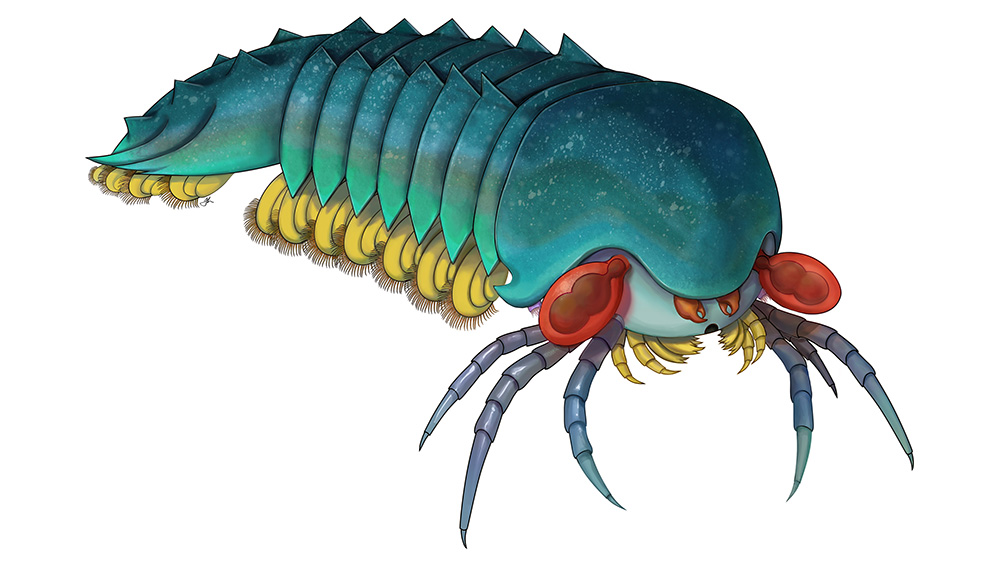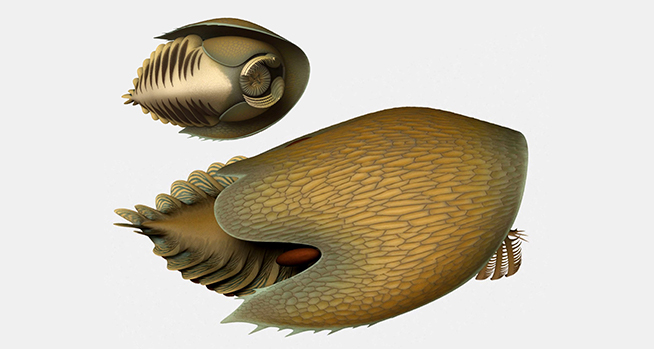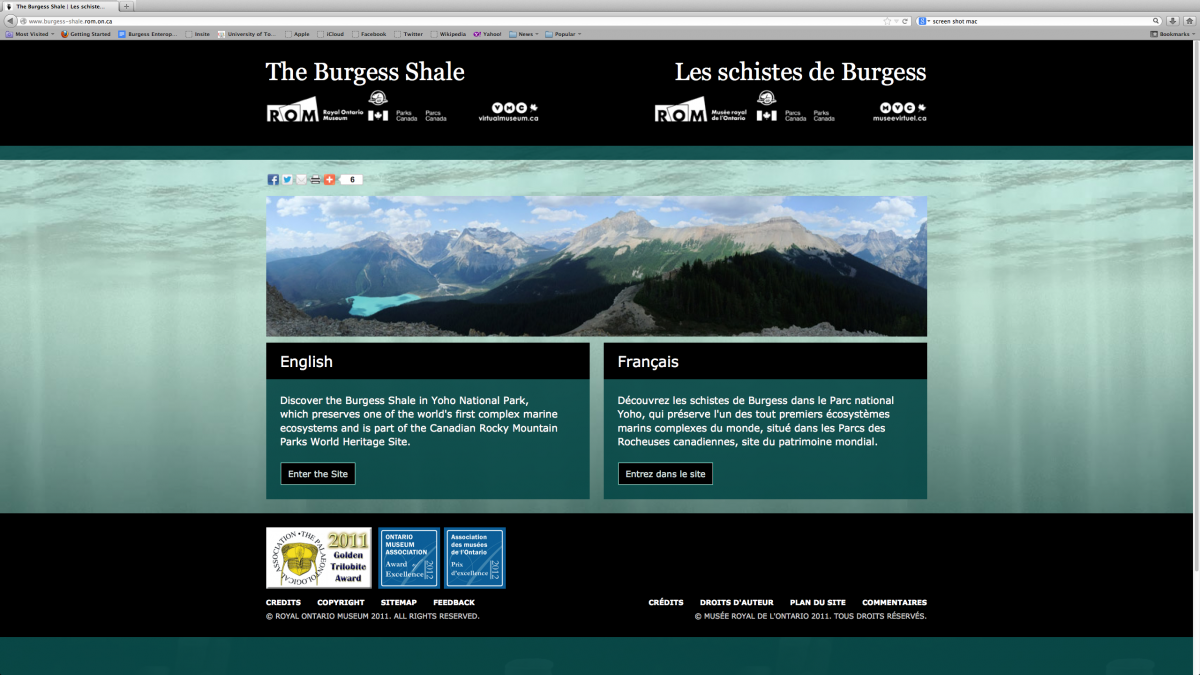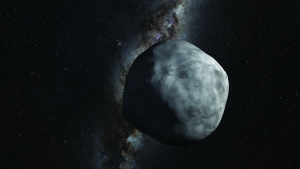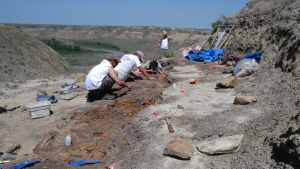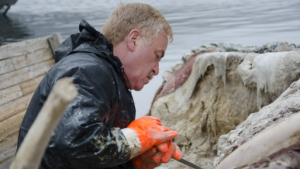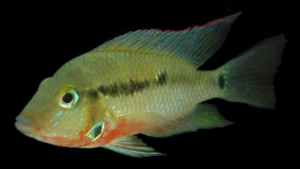
Jean-Bernard Caron
Curator of Invertebrate Palaeontology
Area: Natural History, Fossils & Evolution
Interests: Burgess Shale, Cambrian Explosion, Evolution, Origin of animals, Palaeocology
Exhibitions & Galleries: Gallery of Early Life
Phone: 416.586.5593
WHAT'S NEW►
Half-a-Billion-Year-Old Tiny Predator Unveils the Rise of Scorpions and Spiders
September 11, 2019
Two palaeontologists working on the world-renowned Burgess Shale have revealed a new species, called Mollisonia plenovenatrix, which is now considered to be the oldest chelicerate.
Huge cache of fossils from the Burgess Shale reveal a new species of large predator
August 1, 2019
We recently unveiled fossils of a new large predatory species in a paper in Proceedings of the Royal Society B. This animal had rake-like claws and a pineapple-slice-shaped mouth at the front of an enormous head, and it sheds light on the diversity of the earliest relatives of insects, crabs, spiders, and their kin.
DAWN OF LIFE►
IN THE MEDIA►
Digital & Print
- 2019: 'This species is very special': Granddaddy of the spider discovered by ROM researchers (CBC)
- 2015: Marble Canyon (New Scientist) by Bob Holmes
- 2015: Marble Canyon (Globe & Mail) by Ivan Semeniuk
- 2014: Marble Canyon (GEO magazine - in German) by Susanne Paulsen
- 2009: Burgess Shale Fieldwork (Smithsonian Magazine) by Siobhan Roberts
- 2009: Burgess Shale Research (Earth Magazine) by David B. Williams
Film & Television
- 2017: CHACUN SA ROUTE: JEUNE CHEZ LES FOSSILES
- 2015: NHK (In Japanese)
- 2015: TFO (In French)
- 2014: BBC Fossil Wonderlands by Richard Fortey
- 2010: First Life by Sir David Attenborough
- 2009: The Nature of Things (Gone Sideways with David Suzuki)
For a full list of Burgess Shale stories, see "Publications" below
BLOG►
Follow Jean-Bernard Caron on ROM Blog:
- September 12, 2019: Behind the Paper: Burgess Tales of Arachne (Nature: Ecology & Evolution)
- August 1, 2019: Huge cache of fossils from the Burgess Shale reveal a new species of large predator
- January 19, 2018: The life cycle of a new fossil: Meet the ancient cousin of the earthworm
- December 19, 2017: Habelia, a fossil predator with a “multi-tool” head
- August 3, 2017: Meet a worm with invibility power
- January 30, 2017: Three cheers for Burgess Shale’ newest oddball animal, a worm with waving “arms”
- December 17, 2015: Burgess Shale fossil site reveals oldest evidence of brood care
- June 24, 2015: The restudy of Hallucigenia from the Burgess Shale
- June 11, 2014: A Fish with a Big Bang
- Feb 11, 2014: Mighty Burgess Shale site discovered in Kootenay National Park
- July 31, 2013: Thorny worms that swarmed in Cambrian seas
- Jan 18. 2013: My Journey with Sir David Attenborough
RESOURCES►
ABOUT JEAN-BERNARD CARON►
B.Sc., Earth and Life Sciences, University Blaise Pascal, Clermont-Ferrand, 1997
M.Sc., Earth Sciences, University Claude-Bernard, Lyon, 1999
Ph.D., Zoology, University of Toronto, 2005
Jean-Bernard Caron is a Senior Curator of Invertebrate Palaeontology at the ROM.
Previous position held at the ROM: Associate Curator and Curator of Invertebrate Palaeontology (2006-2016)
A profound curiosity about fossils during his childhood led Jean-Bernard Caron to collect and curate his own personal fossil collection in his native France. By the age of 10, he knew he wanted to become a professional palaeontologist. As a teenager, he often joined various professional field crews across Europe for summer field expeditions collecting fossils, and the experience gained as a volunteer field assistant led to an invitation from Desmond Collins, then Curator of Invertebrate Palaeontology at the ROM, to join his field crew at the famous Burgess Shale fossil deposit in British Columbia in 1998. This was his first visit to Canada, and he returned to the Burgess Shale as a ROM volunteer for the following two summer field seasons.
His Master's thesis dealt with Banffia constricta, one of the most bizarre animals known from the Burgess Shale. This study was followed by a PhD on the taphonomy and paleoecology of the Burgess Shale community. By the end of his PhD project, Jean-Bernard had examined about half the Burgess Shale specimens (more than 70,000 fossils) stored at the ROM, which houses over 150,000 specimens, representing the world’s largest collection of its kind. After being awarded a Natural Sciences and Engineering Research Council post-doctoral fellowship (Government of Canada), he joined the ROM as Associate Curator of Invertebrate Paleontology in early 2006, thus finally fulfilling his long-standing childhood dream.
At present, his main responsibilities are to curate and interpret fossils from the very large ROM Burgess Shale collection as well as to continue fieldwork activities. The ROM collection represents a real Pandora’s Box for science, with many new organisms still to be described. He also studies fossils from other Burgess Shale-type deposits, particularly in China.
At the end of 2011, Jean-Bernard launched the "Virtual Museum of Canada website on the Burgess Shale", a joint effort between the ROM and Parks Canada. This bilingual website has received over 2.3 Million pageviews since Jan 1st, 2012.
Academic Links
Associate Professor, University of Toronto - Ecology and Evolutionary Biology
Associate Professor, University of Toronto - Earth Sciences Department
See also Focus on Research page.
Awards & Recognition
Jean-Bernard was the recipient of the 2010 Pikaia award from the Canadian Geological Association in recognition of his contribution to the profile of Canadian paleontology through his research. The nomination citation (PDF) praised him as "an exceptionally innovative and productive young paleontologist who shows promise for continuing excellence in Canadian paleontological research."
Jean-Bernard received two awards for "Virtual Museum of Canada website on the Burgess Shale": the Paleontological Association Golden Trilobite Award (2011) and the Ontario Museum Association Award for Excellence in Publications (2012).
Research Grants
Jean-Bernard's research at the ROM is partially funded by an NSERC Discovery grant (2017-2022) under the program, "Burgess Shale fossils from Marble Canyon (Canadian Rockies) and the early diversification of animals" see Research Page for more information.
STUDENTS►
Karma Nanglu (PhD) - (2013-current)
Cédric Aria (PhD) - (2012-2017)
Lorna O'Brien (PhD) completed (2008-2013)
Martin Smith (PhD) completed (2008-2012)
Allison Daley (PhD) completed (2006-2010)
PUBLICATIONS►
Google scholar profile, with list of citations, click here.
*Doctoral research supervised or co-supervised
-
Aria*, C. and Caron, J.-B. 2019. A middle Cambrian arthropod with chelicerae and proto-book gills. Nature. https://www.nature.com/articles/s41586-019-1525-4
-
PRESS RELEASE: ROM
-
-
Moysiuk*, J. and Caron, J.-B. 2019. A new hurdiid radiodont from the Burgess Shale evinces the exploitation of Cambrian infaunal food sources. Proceedings of the Royal Society B 286.
-
PRESS RELEASE: ROM
- BLOG: Huge cache of fossils from the Burgess Shale reveal a new species of large predator
-
-
Nanglu*, K. and Caron, J.-B. 2018. A new Burgess Shale polychaete and the origin of the annelid head revisited. Current Biology 28(2), 319-326.e311
- PRESS RELEASE: ROM
- SELECTED MEDIA LINKS: CBC, Livescience, National Post
- BLOG: The life cycle of a new fossil: meet the ancient cousin of the earthworm
- Bicknell, R. D. C., Paterson J. R., Caron, J.-B. and C. B. Skovsted 2018. The gnathobasic spine microstructure of recent and Silurian chelicerates and the Cambrian artiopodan Sidneyia: Functional and evolutionary implications. Arthropod Structure & Development 47(1): 12-24.
-
Aria*, C. and Caron, J.-B. 2017. Mandibulate convergence in an armoured Cambrian stem chelicerate. BMC Evolutionary Biology 17, 261.
- PRESS RELEASE: ROM
- SELECTED MEDIA LINKS: CBC, Livescience
- BLOG: Habelia, a fossil predator with a "multi-tool" head
- Parry, L. A., Smithwick F., Nordén K.K., Saitta E.T., Lozano-Fernandez J., Tanner A.R., Caron, J.-B. et al. 2017. Soft-bodied fossils are not simply rotten carcasses – Toward a holistic understanding of exceptional fossil preservation. BioEssays 40, 1700167-n/a.
-
Briggs, D.E.G, Caron, J.-B (2017). A large Cambrian chaetognath with supernumerary grasping spines. Current Biology. 27(16): p2536–2543.e1.
- PRESS RELEASE: ROM
- SELECTED MEDIA LINKS: CBC, Livescience
- BLOG: Meet a Worm with Invisibility Powers
-
Aria*, C., Caron, J.-B (2017). Burgess Shale fossils illustrate the origin of the mandibulate body plan. Nature. 545, 89-92.
- PRESS RELEASE: ROM
- SELECTED MEDIA LINKS: Washington Post, The Guardian, The Globe and Mail
- BLOG: Tokummia, Reconstructing the origin of animals’ greatest success story
-
Caron, J.-B., Aria* C (2017). Cambrian suspension-feeding lobopodians and the early radiation of panarthropods. BMC Evolutionary Biology.
-
PRESS RELEASE: ROM
-
SELECTED MEDIA LINKS: Canadian Geographic,
-
-
Moysiuk*, J., Smith, M., Caron, J.-B. (2017). Hyoliths are Palaeozoic lophophorates. Nature. 541, 394–397.
- PRESS RELEASE: ROM
- SELECTED MEDIA LINKS: CBC News, BBC News, New York Times
-
Nanglu*, K., Caron, J.-B., Conway Morris S. & Cameron C. 2016. Cambrian suspension-feeding tubicolous enteropneusts. 14:56. BMC Biology. Publication July 7.
- PRESS RELEASE: ROM
- SELECTED MEDIA LINKS: CBC News, New York Times
-
Caron J.-B. & Vannier J. (2015). Waptia and the diversification of brood care in early arthropods. Current Biology, Published online Dec. 17. (doi:10.1016/j.cub.2015.11.006).
- PRESS RELEASE: ROM
- SELECTED MEDIA LINKS: CBC News, Calgary Herald
- Topper, T. P., Strotz, L. C., Holmer, L. E. & Caron, J.-B. (2015). Survival on a soft seafloor: life strategies of brachiopods from the Cambrian Burgess Shale. Earth-Science Reviews 151, 266-287 (doi:http://dx.doi.org/10.1016/j.earscirev.2015.10.015).
- O’Brien, L. J. & Caron, J.-B. (2015). Paleocommunity analysis of the Burgess Shale Tulip Beds, Mount Stephen, British Columbia: Comparison with the Walcott Quarry and implications for community variation in the Burgess Shale. Paleobiology, published online Nov. 6. (doi:10.1017/pab.2015.17).
-
Smith M.R. & Caron J.-B. (2015). Hallucigenia's head and the pharyngeal armature of early ecdysozoans. Nature 523(7558), 75-78. (doi:10.1038/nature14573).
- PRESS RELEASE: ROM
- SELECTED MEDIA LINKS: New York Times, CBC News
- Nanglu, K., Caron, J.-B., and Cameron, C. B., (2015). Using experimental decay of modern forms to reconstruct the early evolution and morphology of fossil enteropneusts. Paleobiology, v. 41, no. 03, p. 460-478.
- Aria, C. & Caron J.-B. (2015). Cephalic and limb anatomy of a new isoxyid from the Burgess Shale and the role of “stem bivalved arthropods” in the disparity of the frontalmost appendage. PloS one 10(6):e0124979.
-
Aria, C., Caron, J.-B., and Gaines, R. (2015) A large new leanchoiliid from the Burgess Shale and the influence of inapplicable states on stem arthropod phylogeny. Palaeontology (doi: 10.1111/pala.12161).
- PRESS RELEASES: ROM, University of Toronto
- SELECTED MEDIA LINKS: LiveScience.com, CBC News
- Topper, T. P., Strotz, L. C., Holmer, L. E., Zhang, Z., Tait, N. N., & Caron, J.-B. (2015) Competition and mimicry: the curious case of chaetae in brachiopods from the middle Cambrian Burgess Shale. BMC Evolutionary Biology, v. 15, no. 42.
- LoDuca, S. T., Caron, J.-B., Schiffbauer, J. D., Xiao, S. & Kramer, A. (2015) A reexamination of Yuknessia from the Cambrian of British Columbia and Utah. Journal of Paleontology, v. 89, no. 01, p. 82-95.
- Topper, T. P., Holmer L. E. & Caron J.-B. (2014) Brachiopods hitching a ride: an early case of commensalism in the middle Cambrian Burgess Shale. Scientific Reports 4.
-
Conway Morris, S. & Caron J.-B. (2014) "A primitive fish from the Cambrian of North America." Nature. 512(7515):419-422.
- PRESS RELEASE: ROM, University of Toronto
- SELECTED MEDIA LINKS: New York Times, CBC News, National Post, The Economist
- BLOG: A Fish with a Big Bang
- O'Brien, L. J., Caron J.-B., & Gaines R. R. (2014). Taphonomy and depositional setting of the Burgess Shale Tulip Beds, Mount Stephen, British Columbia. PALAIOS 29 (6):309-324.
-
Caron, J.-B., Gaines R. R., Aria, C., Mángano M. G. & M. Streng (2014) "A new phyllopod bed-like assemblage from the Burgess Shale of the Canadian Rockies." Nature Communications 5.
- PRESS RELEASE: ROM; University of Toronto
- SELECTED MEDIA LINKS: Globe and Mail; CBC; LiveScience.com; Calgary Herald
- BLOG: "Mighty Burgess Shale site discovered in Kootenay National Park"
- Zhao, F., Caron, J.-B., Bottjer, D., Hu, S., Yin, Z., & Zhu, M. (2013). Diversity and species abundance patterns of the early Cambrian (Series 2, Stage 3) Chengjiang Biota from China: Paleobiology, v. 40, no. 1, p. 50-69
-
Caron J.-B., Smith M. & Harvey T.H.P. (2013) Beyond the Burgess Shale: Cambrian microfossils track the rise and fall of hallucigeniid lobopodians. Proceedings of the Royal Society B: Biological Sciences 280 20131613. First published online July 31st, 2013 (http://dx.doi.org/10.1098/rspb.2013.1613).
- PRESS RELEASE: ROM; University of Toronto;
- SELECTED MEDIA LINKS: National Geographic; Metro; Toronto Star; Globe & Mail; CTV News; Calgary Herald
- BLOG: ROM ("Thorny worms that swarmed in the Cambrian seas")
- Haug, J., Caron, J.-B. & Haug, C. (2013) Demecology in the Cambrian -- synchronized molting in arthropods from the Burgess Shale. BMC Biology 11, 64. doi:10.1186/1741-7007-11-64
- *Smith, M. (2013) Nectocaridid ecology, diversity and affinity: early origin of a cephalopod-like body plan. Paleobiology 39, 345-357.
- *Daley A, Budd G, & Caron, J.-B. (2013) Morphology and systematics of the anomalocaridid arthropod Hurdia from the Middle Cambrian of British Columbia and Utah. Journal of Systematic Palaeontology First published online 22 Mar 2013. doi:10.1080/14772019.2012.732723
-
Caron J-B, Conway Morris S & Cameron C. (2013) Tubicolous enteropneusts from the Cambrian period. Nature Advance Online Publication. doi:10.1038/nature12017
- PRESS RELEASES: ROM; University of Toronto; Cambridge University
- SELECTED MEDIA LINKS: CBC News; National Geographic; BBC News; Science Daily.com; Live Science.com; Calgary Herald
- Legg DA, Sutton MD, Edgecombe GD, & Caron J.-B. (2012) Cambrian bivalved arthropod reveals origin of arthrodization. Proceedings of the Royal Society B: Biological Sciences 279(1748):4699-4704.
- *Smith M. (2012) Mouthparts of the Burgess Shale fossils Odontogriphus and Wiwaxia: implications for the ancestral molluscan radula. Proceedings of the Royal Society B: Biological Sciences 279 (1745):4287-4295.
- Zhao F., Hu S., Caron J.-B., Zhu M., Yin Z. & Lu M. (2012) Spatial variation in the diversity and composition of the Lower Cambrian (Series 2, Stage 3) Chengjiang Biota, Southwest China. Palaeogeography, Palaeoclimatology, Palaeoecology 346-347:54-65.
-
Conway Morris S & Caron J.-B. (2012) Pikaia gracilens Walcott, a stem-group chordate from the Middle Cambrian of British Columbia. Biological Reviews 87(2): 480-512.
- PRESS RELEASES: ROM; University of Toronto; Cambridge University
- SELECTED MEDIA LINKS: CBC News; CTV News; The Globe and Mail; The Guardian; National Post; Radio Canada; La Recherche [Pikaia among the 10 most significant science finds of the year 2012]
-
Minter NJ, Mángano MG & Caron J.-B. (2012) Skimming the surface with Burgess Shale arthropod locomotion. Proceedings of the Royal Society B: Biological Sciences 279(1733):1613-1620.
- PRESS RELEASES: University of Saskatchewan in Saskatoon
- SELECTED MEDIA LINKS: CBC News; CBC radio; Live Science
-
*O'Brien LJ & Caron J.-B. (2012) A New Stalked Filter-Feeder from the Middle Cambrian Burgess Shale, British Columbia, Canada. PLoS ONE 7(1):e29233.
- PRESS RELEASES: University of Toronto
- SELECTED MEDIA LINKS: CBC News
-
*Smith M & Caron J.-B. (2010) Primitive soft-bodied cephalopods from the Cambrian. Nature 465(7297):469-472.
- PRESS RELEASES: University of Toronto
- SELECTED MEDIA LINKS: CBC News; Discovery Channel; Science Daily
-
Caron J.-B., Gaines R, Mangano G, Streng M, & Daley A (2010) A new Burgess Shale-type assemblage from the "thin" Stephen Formation of the Southern Canadian Rockies. Geology 38(9):811-814.
- PRESS RELEASES: Pomona College
- SELECTED MEDIA LINKS: CBC News
- Caron J.-B., Conway Morris S, & Shu D (2010) Tentaculate fossils from the Cambrian of Canada (British Columbia) and China (Yunnan) interpreted as primitive Deuterostomes. PLoS ONE 5(3):1-13.
- Zhao F, Caron J-B, Hu SX, & Zhu M (2009) Quantitative analysis of taphofacies and paleocommunities in the Early Cambrian Chengjiang Lagerstätte. PALAIOS 24:826-839.
-
*Daley AC, Budd GE, Caron J.-B., Edgecombe GD, & Collins D (2009) The Burgess Shale anomalocaridid Hurdia and its significance for early euarthropod evolution. Science 323:1597-1600.
- PRESS RELEASES: ROM;
- SELECTED MEDIA LINKS: CBC News; Discovery Channel; New Scientist; Radio Canada; The Star
- Caron J.-B. & Jackson DA (2008) Paleoecology of the Greater Phyllopod Bed community, Burgess Shale. Palaeogeography, Palaeoclimatology, Palaeoecology 258:222-256.
- Caron J.-B. (2008) Palaeontology: Ancient worms in armour. Nature 451(7175):133-134.
- Vannier, J., Caron, J.-B., Yuan, J. L., Briggs, D., Collins, D., Zhao, Y. L., and Zhu, M.Y. (2007) Tuzoia: morphology and lifestyle of a giant bivalved arthropod of the Cambrian seas. Journal of Paleontology 81:445-471.
-
Conway Morris S & Caron J.-B. (2007) Halwaxiids and the early evolution of the lophotrochozoans. Science 315:1255-1258.
- PRESS RELEASES: ROM;
- SELECTED MEDIA LINKS: CBC News; LiveScience.com; Radio Canada; Reuters; Science Daily; The Star
- Caron J.-B., Scheltema AH, Schander C, & Rudkin D (2007) Reply to Butterfield on stem-group "worms:" fossil lophotrochozoans in the Burgess Shale. BioEssays 29:200-202.
-
Caron J.-B., Scheltema AH, Schander C, & Rudkin D (2006) A soft-bodied mollusc with radula from the Middle Cambrian Burgess Shale. Nature 442:159-163.
- SELECTED MEDIA LINKS: CBC News; Science Daily
- Caron J.-B. & Jackson DA (2006) Taphonomy of the Greater Phyllopod Bed Community, Burgess Shale. PALAOIS 21:451-465.
- Caron J.-B. (2005) Banffia constricta, a putative vetulicolid from the Middle Cambrian Burgess Shale. Transactions of the Royal Society of Edinburgh 96:95-111.

